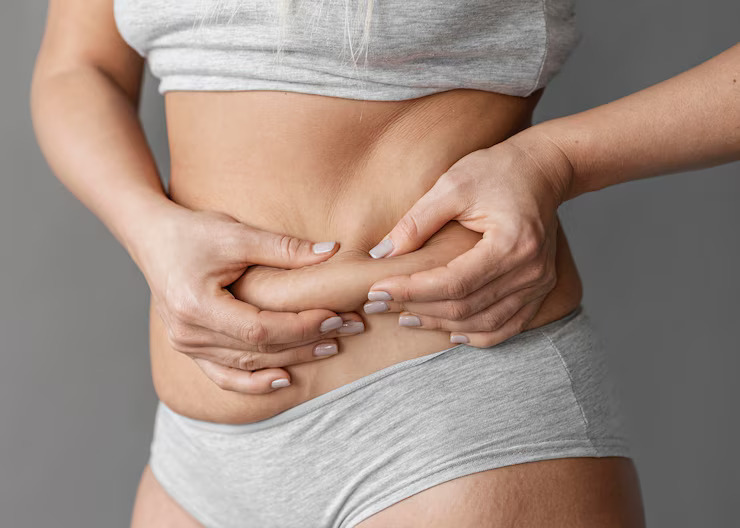Fibroid belly: Unmasking the fibroid stomach bulge
Do you feel like your belly is constantly bloated, but it’s not related to diet or digestion? You could be dealing with a fibroid belly bulge.
Uterine fibroids—non-cancerous growths in the uterus—can lead to noticeable abdominal swelling, especially when they grow large or multiply.
In this blog, we’ll explain what causes this fibroid belly and how to tell if persistent bloating is actually a fibroid belly bulge.
Understanding fibroid belly bulge
A fibroid belly bulge happens when uterine fibroids grow large enough to stretch and expand the uterus, leading to visible abdominal distention. Uterine fibroids—also called leiomyomas or myomas—are benign (non-cancerous) growths that form in or around the uterus.
For many women, these fibroids can cause the lower abdomen to protrude, often mimicking the appearance of weight gain or even early pregnancy.
The size and position of the fibroids influence the severity of the bulge—larger fibroids or multiple fibroids can make the abdomen feel hard and firm rather than soft, like regular bloating.

Characteristics of a fibroid belly bulge
- Abdominal distension: The expansion of the lower abdomen is a prominent indicator of a fibroid belly bulge. As fibroids increase in size, they can cause the uterus to enlarge, leading to a noticeable bulge that closely resembles the appearance of pregnancy.
- Changes in abdominal shape: The growing fibroids can also change the natural shape of the abdomen, giving it a rounder, firmer, or more pronounced appearance—especially in the lower belly area.
Common symptoms that accompany a fibroid belly
- Abdominal distention or firmness
- Pelvic pressure or pain
- Unexplained weight gain
- Heavy or prolonged menstrual bleeding
- Frequent urination
- Excessive fatigue
- Back pain or leg pain
- Pain during intercourse
If you’re experiencing a persistent belly bulge alongside one or more of these symptoms, it may be time to get evaluated for uterine fibroids.
Also Read – Which size of fibroid is dangerous?
Why do fibroids cause a belly bulge?
Fibroids can vary greatly in size, from as small as a seed to as large as a melon. As they grow, they may push against surrounding organs—including the intestines and bladder—which can lead to bloating, pressure, and a visibly larger abdomen.
Subserosal fibroids (which develop on the outer surface of the uterus) are especially known for causing a fibroid belly.
Some women with large fibroids have described their appearance as looking “five months pregnant”—even if they aren’t pregnant at all.

Causes and factors contributing to a fibroid belly
Uterine fibroids
The main reason behind a fibroid belly is the presence of uterine fibroids—benign tumors that grow within or around the uterus. As these fibroids grow larger or increase in number, they can expand the uterus and cause a visible belly bulge.
Hormonal influence
Estrogen and progesterone—two key reproductive hormones—play a major role in fibroid growth. This is why fibroids often develop or enlarge during a woman’s reproductive years and may shrink after menopause.
Genetic predisposition
Having a family history of fibroids significantly increases the likelihood of developing them. Women whose mothers or sisters had fibroids are more likely to experience them as well.
Reproductive age
Fibroids are most commonly seen in women between the ages of 30 and 50. During this time, hormone levels are at their peak, contributing to the potential growth and impact of fibroids.
Management and treatment: Navigating the fibroid belly journey
Watchful waiting:
If fibroids are not causing significant discomfort or symptoms, a watch-and-wait approach may be recommended. Regular monitoring and assessments help track changes in the size and symptoms of fibroids over time.
Medication:
Hormonal medications, like gonadotropin-releasing hormone agonists or certain birth control pills, can help control fibroid-related symptoms. These may reduce the size of fibroids temporarily and ease issues like heavy bleeding or abdominal bulging.
Lifestyle changes:
- Healthy diet: Maintaining a nutrient-rich diet plays a key role in managing fibroid symptoms. Focus on fruits, vegetables, whole grains, and foods with anti-inflammatory benefits, like fatty fish, flaxseeds, and leafy greens.
- Regular exercise: A balanced routine of aerobic exercise, strength training, and flexibility work can support physical and mental well-being and help minimize the discomfort associated with fibroids.
- Holistic wellness: Incorporating mindfulness practices such as meditation, yoga, and breathing exercises can significantly help manage stress and promote overall wellness.
Surgical interventions:
- Myomectomy: This procedure focuses on removing individual fibroids while leaving the uterus intact. It’s often the preferred choice for women who want to preserve their fertility and plan for future pregnancies. This can often be done by laparoscopy – key-hole surgery.
- Hysterectomy: In cases where symptoms are severe or when fertility is not a concern, a hysterectomy—removal of the uterus offers a permanent solution and fully eliminates the fibroid belly bulge.
- Uterine Artery Embolization (UAE): This technique cuts off the blood flow to the fibroids, causing them to shrink gradually. It’s a less invasive option that preserves the uterus and can reduce abdominal protrusion over time.
Fibroid belly before and after: What to expect?
For many women, the transformation after treatment can be life-changing. A fibroid belly before and after comparison often shows a dramatic reduction in abdominal size, improved comfort, and relief from symptoms like pressure and pain.
Not only can your belly appear flatter and more natural post-treatment, but your energy, confidence, and quality of life can also improve significantly.
Contact Dr Ibrahim Abd Elrahman for fibroid belly treatment in Dubai
If you’re struggling with a persistent belly bulge that doesn’t seem to go away, it’s time to consider expert evaluation and care.
Dr. Ibrahim Abd Elrahman, an Advanced Laparoscopic Surgeon and the renowned best gynecologist in Dubai, offers advanced, personalized treatment solutions for uterine fibroids.
With over two decades of experience, Dr. Ibrahim is highly skilled in managing complex cases, including large fibroids, advanced-stage endometriosis, and pelvic floor conditions. His approach combines cutting-edge surgical techniques with genuine compassion, ensuring you receive the best clinical outcomes and the support and care you deserve throughout your journey.

Fibroid belly: Unmasking the fibroid stomach bulge
Fibroid belly: Unmasking the fibroid stomach bulge Do you feel like your belly is constantly bloated, but it’s not related to diet or digestion? You could be dealing with a fibroid belly bulge. Uterine fibroids—non-cancerous growths in the uterus—can lead to noticeable abdominal swelling, especially when they grow large or

Endometriosis vs PCOS: How To Tell The Difference?
Understanding The Differences Between PCOS and Endometriosis Two Conditions, One Goal: Finding the Right Diagnosis! Struggling with irregular periods, painful cramps, or unexplained weight changes? If you’ve been trying to make sense of your symptoms, you may have come across two common yet often misunderstood conditions— PCOS and Endometriosis. While

Endometriosis weight gain: Causes and how to lose weight
Does Endometriosis Cause Weight Gain? If you’re struggling with endometriosis weight gain, you’re not alone. Many women with this condition experience unexplained weight fluctuations, bloating, and difficulty losing weight. But does endometriosis cause weight gain, or is it due to other factors? Research suggests hormonal imbalances, inflammation, and certain medications

